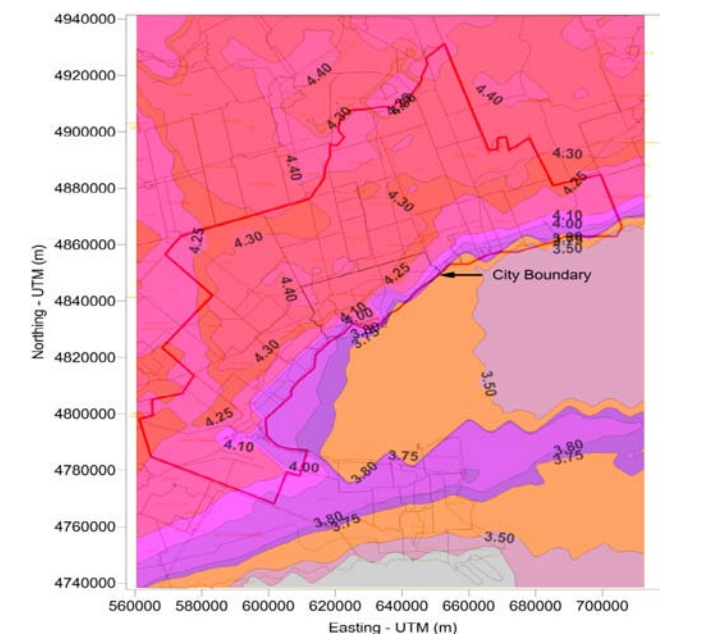Designing for Future Ontario Climates – Homes and Cottages
Map showing the extreme daily maximum temperature change in degrees
Climate change is topping national, provincial, and municipal conversations these days: and for good reason. The fast few years have been the warmest on record (“NASA, NOAA Analyses Reveal Record-Shattering Global Warm Temperatures in 2015“) and the perils of business-as-usual become apparent. Ontario is implementing a Cap and Trade system, following in the footsteps of BC and Quebec. The Prime Minister is holding meetings with the Premieres and Presidents to implement a nation-wide, and continent-wide strategy. But in all of the best cast scenarios the climate will warm. And one implication of climate change is in the weather we receive.
Climate is defined as “the weather conditions prevailing in an area in general or over a long period”, while weather is defined as “the state of the atmosphere at a place and time as regards heat, dryness, sunshine, wind, rain, etc.”
On an interesting webinar this week hosted by Mike Williams (
Technical Director, Sustainability) and James W.S. Young, (Senior Consultant, Air Quality & Weather) of RWDI about resilient design and climate change, we learned some of the intricacies of future weather forecasting at high resolution in order to predict how the climate will be changing in each square kilometer of the city from the years 2040-2049.
Mike and James suggested that the implications of these changes require resilience and adaptability in the buildings we build as well as a re-focusing on strategies around energy-use. Resilience might be as simple as ensuring we have air-tight, well-sealed, and well-insulated building standards to ensure that in the event of a sudden or violent storm with a power outage people stay dry and comfortable. The black-out in the Eastern Seaboard, which we have talked about in a previous blog post on resilient design occurred in the summer: but if it occurred in the winter, there would have been massive damage and headaches from pipes freezing and a risk of loss-of-life due to heat loss and hypothermia.
In the webinar they also pointed to a very interesting study conducted for the City of Toronto entitled “Toronto’s Future Weather and Climate Driver Study” which opens as follows:
In order to more effectively plan municipal infrastructure investment and provision of services, the City of Toronto needs to know what currently influences Toronto’s present weather and climate. The City needs to determine how these influences are likely to change, and how severe the consequences are likely to be in the future. In simple terms, the City of Toronto needs a better understanding of why Toronto gets the weather and climate it gets now and what weather and climate it can expect to get in the future.
The Toronto’s Future Weather & Climate Driver Study shows that in the next 50 years in Toronto we can expect:
• Less snow and more rain in the winter
• 26 fewer snow days per year, 9 less in December
• Slightly more precipitation (snow plus rainfall) overall
• Marked rainfall increases in July (80%) and August (50%)
• Extreme rainstorm events, fewer in number but more extreme
• Average annual temperatures increase by 4.4C
• The projected average winter temperature increase by 5.7C.
• The projected average summer temperature increase by 3.8C.
• The extreme daily minimum temperature rises by 13C (i.e., becomes less cold).
It is well worth looking into this study further as it is very fascinating.
Thanks to Mike and James of RWDI for the webinar and the interesting brief on resiliency and adaptability!

